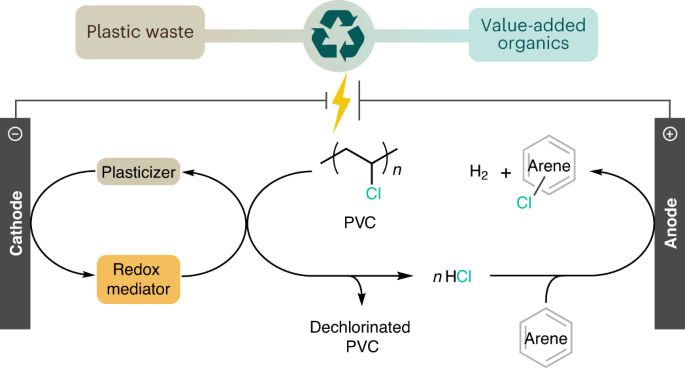2022-11-30 ミシガン大学
熱を使わずにポリ塩化ビニルをリサイクルする方法を探すため、研究者は電気化学の研究を開始した。その過程で、研究チームは、リサイクルの大きな難題の1つである可塑剤が、塩ビを分解する方法に使えることを発見した。実際、可塑剤があると効率が上がり、電気化学的手法で塩酸の問題が解決される。
PVCは、炭素-炭素の単結合からなる炭化水素骨格を持つポリマーである。その炭素の1つ1つに塩素基が結合している。熱で活性化させると、塩酸が急速に飛び出し、ポリマーの骨格に沿って炭素-炭素二重結合ができる。
しかし、研究チームはその代わりに電気化学を使って電子を導入し、系を負に帯電させることに成功した。すると、炭素-塩化物結合が切断され、負電荷をもつ塩化物イオンが生成される。研究者たちは電気化学を利用しているので、システムに電子が導入される速度を測定することができ、それによって塩酸の生成速度を制御することができる。
この酸は、産業界で他の化学反応の試薬として使用することができる。また、塩化物イオンはアレーンという低分子を塩素化するのに使われる。このアレーンは、医薬や農薬の成分として使用することができる。
<関連情報>
- https://news.umich.edu/u-m-team-recycles-previously-unrecyclable-plastic/
- https://www.nature.com/articles/s41557-022-01078-w
廃ポリ塩化ビニルを利用した可塑剤を用いた電解塩素化反応によるクロロアレーンの合成 Using waste poly(vinyl chloride) to synthesize chloroarenes by plasticizer-mediated electro(de)chlorination
Danielle E. Fagnani, Dukhan Kim, Sofia I. Camarero, Jose F. Alfaro & Anne J. McNeil
Nature Chemistry Published:14 November 2022
DOI:https://doi.org/10.1038/s41557-022-01078-w

Abstract
New approaches are needed to both reduce and reuse plastic waste. In this context, poly(vinyl chloride) (PVC) is an appealing target as it is the least recycled high-production-volume polymer due to its facile release of plasticizers and corrosive HCl gas. Herein, these limitations become advantageous in a paired-electrolysis reaction in which HCl is intentionally generated from PVC to chlorinate arenes in an air- and moisture-tolerant process that is mediated by the plasticizer. The reaction proceeds efficiently with other plastic waste present and a commercial plasticized PVC product (laboratory tubing) can be used directly. A simplified life-cycle assessment reveals that using PVC waste as the chlorine source in the paired-electrolysis reaction has a lower global warming potential than HCl. Overall, this method should inspire other strategies for repurposing waste PVC and related polymers using electrosynthetic reactions, including those that take advantage of existing polymer additives.



